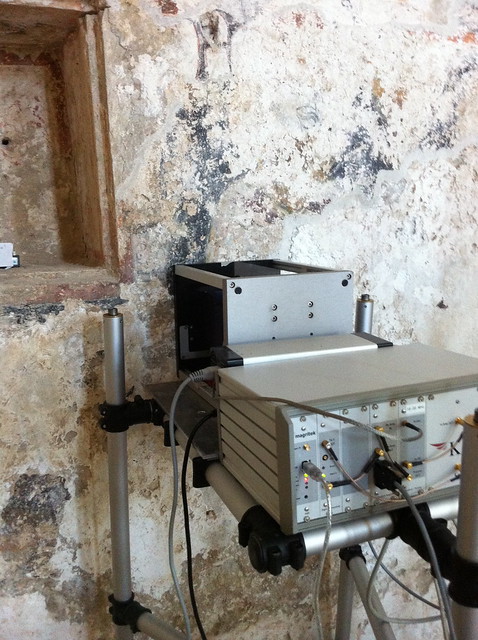Note: Our trip to Greece is so breathtaking that we needed to split it into four-and-a-half blog posts to cover it all. This is the epilogue. You can go back to parts one, two, three, or four if you'd like. But take your time--it's really beautiful!
Our four-part blog about Greece probably didn't answer all of your questions. Like why were we there in the first place? Or what did we eat? (The latter is especially relevant for those of you who know us--and our love for food--too well.)
The whole point of this trip was for Tyler's work. I mentioned the university where I work before, but haven't really taken any time to explain the science. The big idea is that we're trying to help art conservators and restorers to better understand their artifacts of cultural heritage (including paintings, musical instruments, old buildings, etc...) for the sake of preservation, restoration, and education. Our techniques involve the use of Nuclear Magnetic Resonance (the same science that makes MRIs at the hospitals work), but instead of huge magnets in hospitals we use small portable ones that we can take with us, say to Crete. Our apparatus looks like this:

Here, we're looking at layers of mortar and paint on some frescoes in the Dominican Monastery of Saint Peter, built by Dominican monks in the early 13th century and pictured here:

The monastery was in pretty bad shape until recently (I think three years ago) when conservators replaced the roof on the whole building, helping protect it from the elements. Unfortunately for the frescoes, they pick up a lot of water from the sea (the building is right on the coast) and, since the ocean is salty, the salt comes up with the water and, as it migrates through the stone layers, ruins the frescoes. Our apparatus is unique among conservation techniques as it can give us information about what is going on up to about an inch (2.5 cm) into the material (that is, inside the wall) without even touching the wall. (In the picture above, the apparatus is about one millimeter away from the wall. We get close, but we never touch.) These frescoes, after the years, are in pretty bad shape and it seems doubtful that they can be restored, but we hope to learn about mitigating damage from the salt. Turns out that I'm just the guy to do it! (Together with the other scientists that have been doing this for much longer than I have.)
Not only did we take measurements in the monastery for two days (Monday and Tuesday), but there was a meeting of the CHARISMA project (Cultural Heritage Advanced Research Infrastructures: Synergy for a Multidisciplinary Approach to Conservation/Restoration), an EU-sponsored and funded project to get workers from different fields, including science, documentation, history, and restoration, to work together to develop technology and protocols for conservation and restoration. The meetings took place on Thursday and Friday and while, sadly, they contained an inordinately large bureaucratic component, I made several great contacts that will help propel this technology and this postdoc for a while.
The other thing you need to know about our time in Greece is that the food was amazing. I mean really, really great. We ate lots of Greek yogurt with honey and nuts and occasionally dates. (We're totally converted to honey now and are asking ourselves why it took us so long.) We ate moussaka with a lot of nutmeg in the potato mixture and it was awesome. Sara had a whole meal of seafood--a risotto with crab, mussels, and oysters. (If you know Sara's aversion to seafood, this was a big deal.) Tyler ate a cuttlefish in a wine sauce that was awesome. Fried tomato balls with bread and herbs. Souvlaki (which, turns out, is like šašlykai in Lithuania). Stuffed tomatoes and peppers. Dolmadas. Baklava. Homemade, chocolate-dipped ice cream bars (available in all finer bakeries on Crete). And an absolutely fantastic dessert, loukoumades--a fluffy-but-chewier form of a doughnut hole that is topped with a honey syrup and sesame seeds, but, as Sara says, "Is crunchier on the outside and more delicious [than a doughnut hole]." And that's how the whole trip was.
I couldn't help but compare the food we ate in Greece to the food I had in Italy, not that they're so similar, but that the quality was comparable. I'd say that the high-end stuff I ate in Florence (Bistecca alla Fiorentina, Pollo alla burro) was better than the Greek food we had. But when it comes to the day to day fare, the stuff that we could afford to eat, I think Greece may come out on top. (If there are any Italians reading this, our blog must've been hacked. I certainly wouldn't ever write something that inflammatory.) The only way to know is to keep going back. To both places. Lots of times.
Previously on our Tour de Greece: Santorini!
Okay, THIS is a super cool post. Want more of the science, but gotta love the gizmos.
ReplyDelete